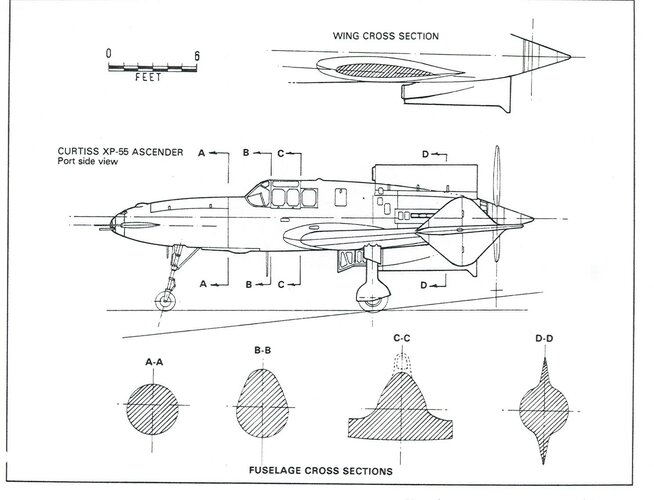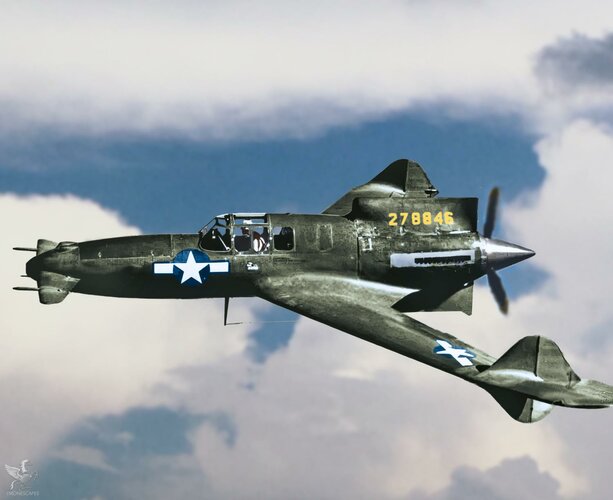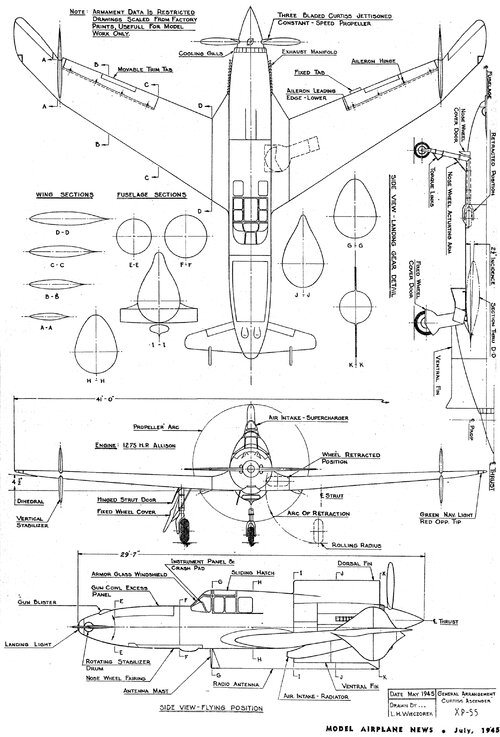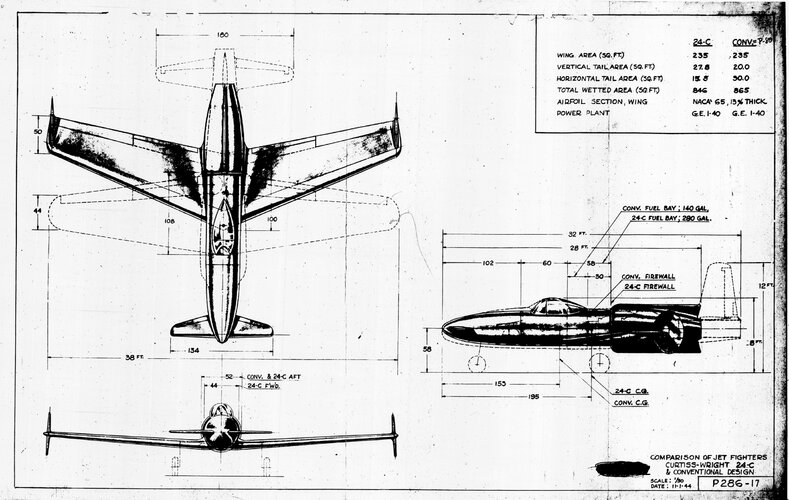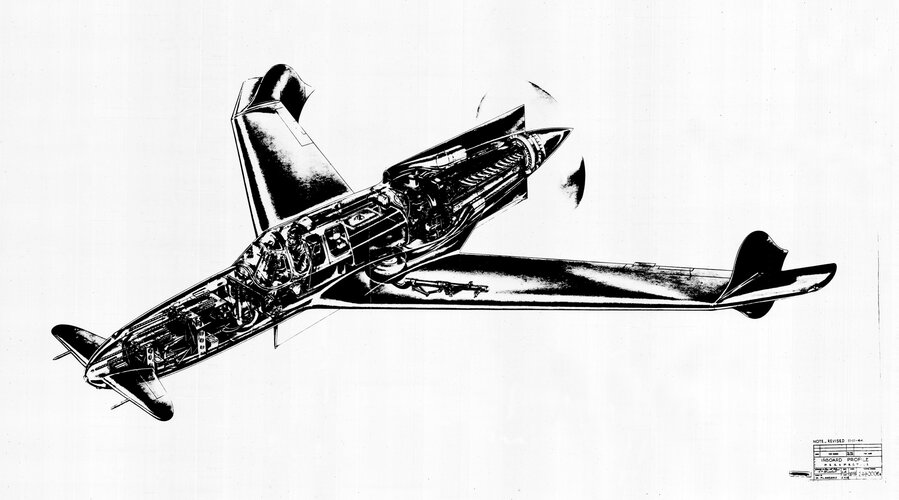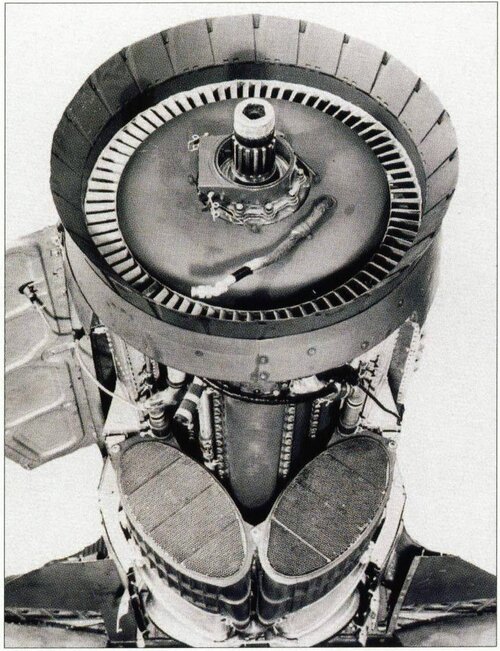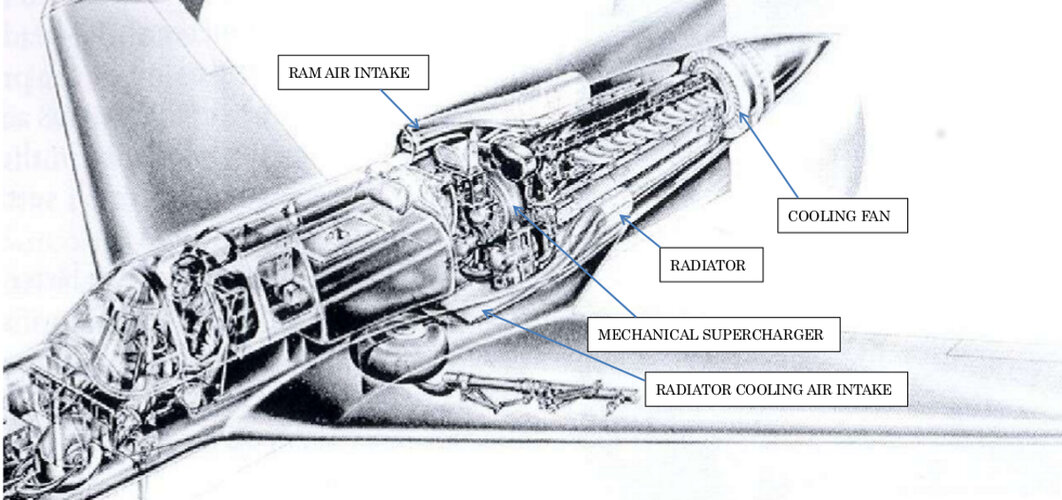Yes, Curtiss Ascender did not use an extension shaft, but it also suffered handlingproblems because the center-of-gravity being too far aft.
Curtiss XP-55
On 27 November, 1939 the USAAC announced the competition ‘Request for data R-40C’ for a very high performance fighter that should be equal to the new European models, to be built in 1941.
The Air Corps Interceptor Pursuit Specification XC-622, required:
Single-engine, single-seater with a top speed of at least 425 mph at 20,000 ft, sufficient to attack or leave combat area at will.
Seven minutes to climb to 20,000 ft.
Good pilot visibility
Four guns armament
Enough maneuverability
One and half hours endurance
The 2,000 hp, 24 cylinder ‘H’, liquid-cooled Pratt & Whitney X-1800-A3G engine was initially proposed.
Curtiss proposed the P-248-01design, an Allison powered CW-21
Demon and the CW-24, an unorthodox tailless-canard fighter, with 45 degrees swept-back wings and pusher propeller.
Around fifty projects were presented by nine different companies. By the end of 1940 six of them had been selected: Vultee (XP-54), Curtiss Wright CW-24 (XP-55), Northrop (XP-56), MacDonnell (Mod 1), Republic (AP-12) and Bell (Mod 13).
The first three qualified ones were never mass manufactured because they were of a too radical pusher design, making a failure of the whole $ 6,000,000 programme.
Throughout aviation history there have been designs of the
canard or ‘tail-first’ types as an alternative to the conventional ‘engine-first’ configuration. However, in spite of the creativity of designers, manufacturers have systematically left aside the mass production of such solutions. When the second generation of fighters designed during the Second World War started to experiment serious aerodynamic problems, due to the transonic flux, they made several tries to solve them using the canard configuration eliminating airscrew slipstream effects on aircraft drag.
With this new configuration the designers tried to elude the problem of compressibility buffeting by installing the wing behind the center of gravity.
The British firm Miles built and fly tested the M.35 and M.39B prototypes as technological demonstrators of the M.39 bomber.
The German Henschel designed the heavy fighter named P.75 that should be propelled by a DB 613 A/B coupled engine and which mass production was abandoned in favor of the Dornier Do 335.
Several prototypes of
canard fighters were built in Italy and USA.
The
canard formula had many advantages for the design of fighters; the armament could be grouped around the nose without any hindrance by either the engine or the propeller and it was very easily accessible for maintenance, ground visibility was considerably improved and it was easier to install a tricycle type undercarriage.
The nose foreplanes had been found to serve the purpose of improving take-off performance and low speed control.
The engine, located behind the pilot, acted as protection against the rear impacts and, in the event of a fire, flames did not go to the cockpit as used to happen with the classical designs. Besides, being joined to the main spar meant less weight and stronger structural sturdiness.
In combat, an enemy pilot not familiar with the new configuration could easily mistake the direction to which the canard fighter moved during the deflection aiming. Same tactic is used by some tropical fishes that have a spot in the shape of a false eye near the tail to confuse their predators.
Only two inconveniencies marred all the advantages: the difficulty to refrigerate the engine and the baling out, due to the position of the pusher airscrews. At a time when ejector seats did not yet exist, the solution was to install an explosive device to detach the propeller in case of emergency.
Early in 1939 the Italians built the Ambrosini S.S.4 a
canard prototype fighter powered by one 960 hp Isotta Fraschini
Asso XI RC.40 engine. The airplane was destroyed in 1941 due to a problem of vibration of the engine mount and the project was cancelled.
On 22 June 1940 the USAAC signed a contract for preliminary development of the Curtiss CW-24 and construction of a wind tunnel model, under the designation XP-55.
Such a radical configuration required the construction of the CW-24B, a flying testbed to prove the design viability.
On 21 December 1941 the CW-24B made its first flight, at Muroc Dry Lake test center, powered by a 275 hp Menasco C-6S-5 engine.
Despite the strong security measures, intelligence services of the IJN obtained enough information about the project to believe that it was the successor of the Curtiss P-40 fighter. Early in 1943 Lieutenant Commander Masaoki Tsuruno, of the First Naval Air Technical Arsenal, proposed the construction of the
canard fighter 18-shi-Otsu J7W
Shinden based on the information obtained on the XP-55.
In fact, the definitive Curtiss XP-55 version was not selected by USAAC for production and only three prototypes were built, two of which were destroyed in accidents.
On 10 July 1942 the USAAF ordered three prototypes, the 42-78845 flew on 13 July 1943 powered by one 1,425 Allison V-1710-95, V-12, liquid-cooled engine, with mechanical supercharger, driving a three-bladed (jettisonable) pusher airscrew.
The aircraft was fitted with laminar-flow swept wings angled back 45 degrees and tricycle undercarriage.
USAAF was unimpressed with the 377 mph top speed reached with the Allison engine versus the 507 mph promised with the X-1800 cancelled in October 1940.
The first prototype showed excessive take off run, dangerous stall behaviour, poor longitudinal stability, low-speed handling problems and engine overheating.
On 15 November 1943 the plane was lost, in an inverted spin, when the engine failed.
The second prototype 42-78846 flew on 9 January 1944 suffering from ‘no-warning before stalling’ phenomena. To improve the stall characteristics the nose elevator and the aileron tabs were modified.
The third prototype 42-78847 was flown on 25 April 1944, fitted with wing extensions and modified nose elevator and armed with four 0.50 cal nose mounted machine guns.
On 27 May 1945 the aircraft crashed when the pilot attempted a barrel roll.
Americans were not lucky with the Curtiss XP-55, after four years of flight testing they have not achieved an airplane sufficiently stable to take part in combat operations.
Although it was less sensible to the compressibility buffeting than conventional airplanes, thanks to a NACA 0015 type wing profile, it was also too heavy and slower than the P-47 and P-51 in service.
Curtiss XP-55 technical data
Power plant: one 1,425 hp Allison V-1710-95, V-12, liquid-cooled engine, with mechanical supercharger, driving a three-bladed (jettisonable) pusher airscrew.
Wingspan: 44.5 ft (13.56 m), length: 29.6 ft (9.02 m), height: 10 ft (3.05 m), wing area: 235 sq. ft (21.83 sq. m), max speed: 390 mph (630 kph), max weight: 7,330 lbs (3,324 kg), service ceiling: 34,600 ft (10,550 m), armament: six 0.50 cal M2 heavy machine guns.
Before cancelling the project, the Curtiss firm proposed the production of a jet version based on the original P 249-C project, known in the specialized literature as P 286-17 or CW 24-C. It would have been propelled by a centrifugal De Havilland H-1B
Goblin turbojet with a fuel tank of 1,059 lt., located behind the pilot, and armed with four 0.50 cal M2 machine guns. Its mass production was abandoned in favor of the Lockheed P-80.
On 31 March 1945 Curtiss proposed two versions of the P-304 a single-jet, medium-range fighter specifically designed to overcome the effects of compressibility, using the accumulated knowledge from the XP-55 programme.
Curtiss CW 24-C technical data
Power plant: de Havilland H-1B
Goblin turbojet with 2,460 lbs (1,114 kgf) static thrust.
Wingspan: 39.36 ft (12 m), length: 28.10 ft (8.57 m), height: 9 ft (2.74 m), armament: four 0.50 cal M2 heavy machine guns.
Curtiss P-304-4 technical data
Power plant: one General Electric TG-180 turbojet with 4,000 lbs (1,814 kgf) static thrust.
Wingspan: 40 ft (12.2 m), length: 33.8 ft (10.3 m), height: 9.5 ft (2.9 m), wing area: 240 sq. ft (21.6 sq. m), max weight: 14,470 lbs (6,564 kg), armament: four 0.50 cal M2 heavy machine guns.
Curtiss P-304-5 technical data
Power plant: one General Electric TG-180 turbojet with 4,000 lbs (1,814 kgf) static thrust.
Wingspan: 40 ft (12.2 m), length: 33.4 ft (10.21 m), height: 9.5 ft (2.9 m), wing area: 240 sq. ft (21.6 sq .m), estimated max speed: 622 mph (1,001 kph) at 10,000 ft, estimated climb rate: 5,530 ft/min, max weight: 14,170 lbs (6,428 kg), combat radius: 500 miles (805 km), armament: four 0.50 cal M2 heavy machine guns.










